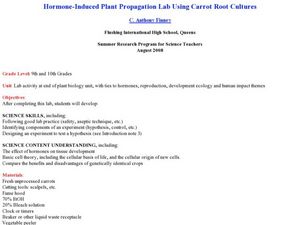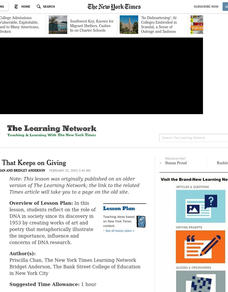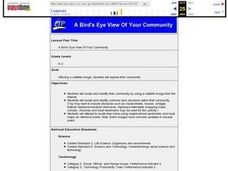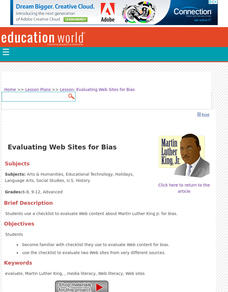Curated OER
Model Organisms: The Genes We Share
In this genetics activity, students access a website to learn about how human genes mutate to cause heritable disorders such as Huntington disease. Students use the information on this website to complete 12 short answer questions.
Curated OER
Bioethics and Humans
Students evaluate "humanity" and conditions associated with it. For this activity lesson students take on issues and construct their own limitations by defining the "human" condition.
Curated OER
Hormone-Induced Plant Propagation Lab using Carrot Root Cultures
Pupils evaluate the importance of hormones in living things. In this biology lesson, students experiment on carrots to differentiate how humans and plants reproduce. They collect data from experiment to answer analysis questions.
Curated OER
PETA Pressure
Students assess what a "target audience" is and how it can be manipulated. They identify characteristics that make up target audiences and check the peta2 Web site for tactics that exploit those characteristics. Acquiring how to spot...
Curated OER
Protecting the Past: Give a Hoot, Don't Loot!
Students, in small groups, simulate an ancient civilization and the art they created, another group represents vandals, and the final group represents archaeologists who try to figure out what life was like for the "ancient peoples". ...
Curated OER
Frog Dissection Lesson Plans
Check out these lesson plans for both actual and virtual frog dissections.
PBS
Technology: Conveniences and Consequences
It's a delicate balance—using technology to improve our lives while still protecting the environment, and ourselves, from the hazards of technology use. Class members examine statistics about the increase in media use, complete a survey...
American Psychological Association
Resource Vetting Rubric
How do you assure that the resources you find for your classes are of good quality? Check out a vetting rubric that suggests eight questions to ask when considering lesson plans, activities, demonstrations, and pictures for classroom use.
Curated OER
Compare and Contrast Night to Life is Beautiful
After reading Elie Wiesel's Night, watching the movie Life is Beautiful, and researching World War II, class members write a comparison essay on the book and film. This includes a prior knowledge activity, discussion in whole and small...
Teach Engineering
Bend That Bar
Bend it, but don't break it. Groups investigate the strength of different materials. Using a procedure in the seventh segment of a 22-part series on aviation, pupils determine how far a rod will bend. They determine the strength-to-mass...
Curated OER
Pilgrims and Puritans
With graphic organizers galore, learners will follow the changes of church and state in early colonial America. They look at the differences between the pilgrims and the puritans in terms of beliefs and life ways. Myths and...
Curated OER
Note-Taking: K.I.S.S. "Keep It Short and Simple"
Note-taking is an essential study skill, and it needs to be taught! In the context of a research project on energy sources, learners find multiple sources, evaluating, paraphrasing, and citing them correctly. Two lists with note-taking...
Curated OER
Back to School (Secondary)
Welcome your class back to school! They will participate in a character education lesson plan in order to build community at the school. First they identify needs of new students by putting themselves in their shoes and create welcome...
Curated OER
Coast-to-Coast Book Design-Part 1: What is a book?
In this first of four lessons on book design, young scholars are introduced to the vocabulary of book design through the use of bookwalks and a non-linear PowerPoint presentation in game-show (Jeopardy!) format.
Curated OER
Low Birthweight Infants
Ninth graders examine why there is a low birth-weight in infants. In this Social Studies instructional activity, 9th graders read articles on the low birth weight. Students debate the different strategies to help combat low birth weight.
Curated OER
The Gift That Keeps on Giving
Students reflect on the role of DNA in society since its discovery in 1953 by creating works of art and poetry that metaphorically illustrate the importance, influence and concerns of DNA research.
Curated OER
Inside/Outside the Human Genome
Students combine a jigsaw learning technique with an inside/outside review game to learn about genes and the Human Genome Project. Students will describe DNA, genes and chromosomes.
Alabama Learning Exchange
We Can Dig It!
Third graders understand the process by which fossils and rocks are excavated. For this fossil and rock lesson, 3rd graders explore the job of the paleontologist in a podcast.
Curated OER
Crossing Borders, Crossing Boundaries?
Students explore how the United States government is using biometrics to secure American borders. They examine the pitfalls of biometrics programs and propose possible ways to strengthen the program.
Curated OER
Get a Life!
Students read a New York Times article associated with the issue of the decoding for genomes, the creation of life in scientific laboratories and various genetic engineering topics. They present speeches of the pro's and con's of these...
Curated OER
A Bird's Eye View Of Your Community
Students locate and identify their community by using a satellite image from the Internet. Students locate and identify common land structures within their community. You may want to include structures such as roads/streets, houses and...
Curated OER
Cyber-crime
Learners discuss what types of Internet activity are or should be considered criminal, examine how criminal prohibitions against certain types of Internet activity are best implemented in law, determine whether computer crimes are unique...
Curated OER
Hunting for the Controversy
You can help students deepen their understanding of the advantages and disadvantages of hunting animals with these lessons and activities.
Curated OER
Evaluating Web Sites for Bias
Students become familiar with checklist they use to evaluate Web content for bias. They use the checklist to evaluate two Web sites from very different sources.

























